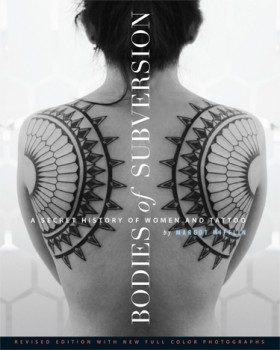
Marked Woman
 Jews have had a heinous association with tattoos: millions were marked, against their will, as they filed through the gates of concentration camps that dotted Europe like the spores of a horrific and malignant disease. Even after the survivors were liberated, the incised blue numbers remained, silent yet eloquent witnesses to the systematic process of dehumanization of which they were only a part.
Jews have had a heinous association with tattoos: millions were marked, against their will, as they filed through the gates of concentration camps that dotted Europe like the spores of a horrific and malignant disease. Even after the survivors were liberated, the incised blue numbers remained, silent yet eloquent witnesses to the systematic process of dehumanization of which they were only a part.
Fast forward to Margot Mifflin’s recently reissued Bodies of Subversion: A Secret History of Women and Tattoos, a brilliant and compulsively readable volume that offers an alternative range of meanings: tattoo as a symbol of empowerment, of catharsis, or as a way of establishing new boundaries for the female body. And one of the featured subjects, Marina Vainshtein, will no doubt cause to you reexamine any ideas you might have had on the topic of Jews and tattoos.
Vainshtein, who these days goes by the name of Spike, was born in the Soviet Union and came to the United States when she was four. She was raised in California, and in the early 1990s, when she was eighteen, began having explicit Holocaust imagery tattooed on her skin. Now, more than twenty years later, she is covered. Mifflin lists these tattoos in some detail: a smoke-belching crematorium, naked bodies hanging from gallows, an old woman chained to a coffin of nails, an escaped inmate dying on a electrified fence, a can of Zyklon B, (used in gas chambers), a skeleton in an open casket reading Kaddish, a star of David, and, in Hebrew, the words, Earth hide not my blood (from the book of Job) andNever Forget. Using her body as both her sounding board and her canvas, Vainshtein has totally subverted both the imagery and the process: her tattoos are chosen and worn with pride, not shame, and they delineate aspects of her heritage in a graphic, unmistakable way—she is the granddaughter of survivors. When questioned about her unusual choice, Mifflin quotes Vainshtein as saying, “Why not have external scars to represent the internal scars?” Mifflin posits that even those born long after the Holocaust still suffer psychic damage—and pain. I had a chance to communicate with Vainshtein via e-mail and here is what she shared with me:
My first tattoo was a MAGEN DAVID on the inside of my left arm. After that was a piece called ADAGIO on my right arm. Adagio is a man playing the violin and represents the orchestra that was placed at the gates of Auschwitz to fool the herd of incoming prisoners into thinking that it was a resort rather than a death camp.
At this point almost 90% of my body is covered in holocaust memorial tattoos; this includes a portrait of my grandparents who survived the pogroms in the Ukraine.
Reaction to my work has spanned the gamut from complimentary/fascination to utter disgust. But what I’ve done over the 22 years has mainly been a tool to educate and shed light on a horrific time in history. Many kids barely skim over WWII these days and some have no idea of the atrocities that occurred. And even still history repeats itself and the barbaric treatment of people continues, i.e. the Armenian holocaust, Sierra Leone, ethnic cleansing in Bosnia, Serbia, Africa etc.
All the artists who have worked on me (12 in total) have either been my friends or have become friends.
Yona Zeldis McDonough is Lilith’s fiction editor.



